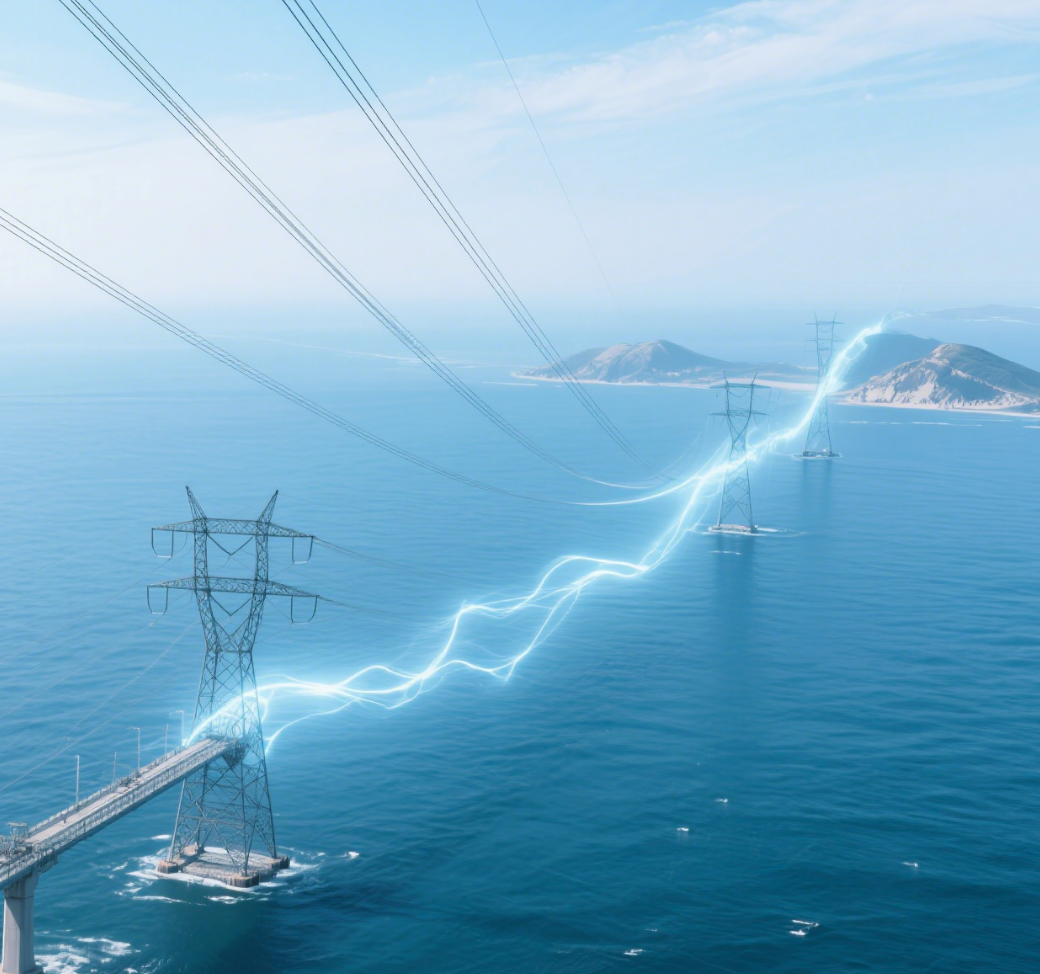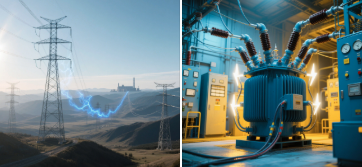Home
Home | Applications | Solutions | Blogs | About Us | Contact Us
- All
- Product Name
- Product Keyword
- Product Model
- Product Summary
- Product Description
- Multi Field Search
Home | Applications | Solutions | Blogs | About Us | Contact Us
Are high tension power lines AC or DC? This is a question that many people have, especially those interested in understanding the backbone of our electrical grid. In this blog, we’ll explore the differences between AC and DC high tension lines, their efficiency, and why each type is used. Whether you’re a student, an engineer, or just curious, join us as we uncover the fascinating world of high tension power lines and how they keep our lights on.
High tension (HT) power lines move large amounts of electricity far across regions. They handle voltages above 1 kilovolt (kV), usually between 11 kV and 400 kV, making them essential for power movement in modern grids.
HT power lines are electric cables designed to carry high voltage electricity. They stretch across long distances between power plants, substations, and industrial zones. By using high voltage, these lines reduce current and lower energy lost as heat.
Electricity travels from power stations to cities using HT lines. It must move fast and efficiently, crossing fields, rivers, and highways. High voltage lets it travel miles while losing less energy. We rely on HT lines to keep power flowing into regions that need it most.
HT power lines form the backbone of the electrical grid. They connect generation sites to substations, where transformers reduce voltage for safe local distribution. Without HT lines, power would struggle to reach faraway cities, factories, and charging stations.
Feature | Details |
Voltage Range | 11 kV – 400 kV |
Main Purpose | Long-distance power transfer |
Energy Efficiency | Low loss over distances |
Grid Role | Backbone for bulk delivery |
HT lines move power fast over long distances. They reduce losses by using high voltage. These lines form a key part of the grid structure.

Alternating Current, or AC, is the type of electricity most homes and businesses use. It changes direction many times each second. In the US, it switches direction 60 times per second (60 Hz). In many other countries, it switches 50 times per second (50 Hz). Power plants generate AC because it is easy to send through long wires. It is also simple to change its voltage using transformers before it enters homes.
Direct Current, or DC, flows in only one direction. Batteries, solar panels, and electronic devices like phones and laptops use DC power. It keeps the same voltage over time without changing direction. Some power systems use DC for specific needs, such as fast charging stations or long undersea cables. We use DC in many devices because it is stable and easy to store in batteries.
AC flows in a wave-like pattern, moving back and forth along the wire. This movement allows it to use transformers to step voltage up or down for different uses. DC flows in a steady, one-way path from the power source to the device. It keeps a constant flow, making it useful for charging and precise electronic systems.
Aspect | Alternating Current (AC) | Direct Current (DC) |
Direction | Changes back and forth | Flows in one direction |
Usage | Homes, businesses, grid power | Batteries, electronics, solar |
Transmission | Long distances with transformers | Specific, efficient delivery |
Voltage Handling | Easy to step up/down | Fixed unless converted |
Voltage measures how strong the electric force is. AC systems can easily increase or decrease voltage using transformers. It helps move power across long distances with less energy loss. Frequency tells us how often AC changes direction each second. It helps keep the system stable and devices working correctly.
For conversion, we use rectifiers to change AC into DC for charging stations and electronics. In some cases, we use inverters to change DC back into AC for use in homes or grids. AC changes direction; DC flows one way. AC uses frequency, DC does not. We use AC for the grid and DC for devices.
Most high tension (HT) power lines around the world use AC, or Alternating Current. It is the standard for moving electricity over long distances because it can change voltage levels easily. Power plants generate AC. We can then step its voltage up or down using transformers, making it practical for moving power from plants to cities.
AC systems let us change voltage to suit different stages of transmission. We step voltage up for long-distance travel. It keeps current low, so less energy is lost as heat. Near cities, we step voltage down for safe delivery to homes and businesses. It keeps the grid stable and reliable.
While AC is common, HVDC (High Voltage Direct Current) systems are used for special needs. HVDC lines carry DC power over extra-long distances or under oceans. They work well when connecting grids in different regions. HVDC reduces energy loss and helps control how power moves between countries.
Feature | AC in HT Lines | DC in HT Lines (HVDC) |
Usage | Most global transmission | Specific, long-distance use |
Voltage Change | Easy with transformers | Needs converters |
Losses | Low over moderate distances | Lower over very long distances |
Typical Applications | Power plants to cities | Undersea cables, inter-region |
Most HT lines use AC for easy voltage control. HVDC is used in select cases for efficient, controlled delivery. AC keeps power flowing across regions every day.

AC makes it easy to change voltage. Transformers can step up voltage for long-distance transmission and step it down for local use. This flexibility helps AC power lines deliver electricity efficiently.
AC supports a stable grid. It allows power plants to sync and share energy. This means a steady supply of electricity, even if one plant has issues. The grid stays balanced and reliable.
For distances under 600 km, AC is cheaper. It needs fewer conductors and simpler equipment. This makes AC the go-to choice for most power lines, keeping costs down while delivering power effectively.
Understanding these points shows why AC is the choice for most high tension power lines.
High Voltage Direct Current (HVDC) transmission is a special way to send electricity. It uses direct current instead of alternating current. HVDC is great for very long distances, like 600 km or more. It’s also used for underwater cables and linking grids that don’t sync well. This makes HVDC perfect for unique challenges.
HVDC has some cool benefits. It loses less power over long distances. Unlike AC, it doesn’t have reactive power losses. This means more electricity reaches its destination. HVDC also gives better control over power flows between different regions. It’s like a super-efficient power highway.
HVDC lines are used in many cool projects. The Pacific DC Intertie in the USA links power grids over long distances. China has ultra HVDC lines that move renewable energy from faraway places. Undersea cables, like the UK-Norway North Sea Link, use HVDC to connect countries. These lines show how HVDC can solve big power challenges. Understanding HVDC helps us see why it’s used in special cases.
Both AC and DC power lines lose energy as heat due to resistance. This is called I⊃2;R loss. In AC lines, the loss depends on the current and resistance. DC lines also have I⊃2;R loss, but they often have lower current for the same power, leading to less heat loss. This makes DC more efficient over long distances.
AC lines deal with reactive power. This is power that doesn’t do useful work but is needed to maintain voltage. Reactive power can cause inefficiencies and increase losses. DC lines don’t have this issue, making them simpler and more efficient for long-distance transmission.
DC lines need special converter stations to change AC to DC and back. These stations are expensive but help reduce losses over long distances. They make DC a good choice for very long lines, even though the initial cost is high.
As we use more renewable energy, both AC and DC lines will play a role. AC lines are still great for shorter distances and local grids. DC lines will be important for long-distance transmission of renewable energy, like solar from deserts or wind from remote areas. Both types will help us build a cleaner energy future.
Understanding these differences helps us see how AC and DC lines can work together to meet our energy needs.
AC and DC high tension lines have different tower designs. AC lines often use three conductors arranged in a triangle. DC lines can use two conductors side by side. This means DC towers can be simpler and sometimes smaller.
Both AC and DC lines need insulation to keep electricity safe. AC lines need extra clearance for reactive power. DC lines need less clearance, making them more compact. This can save space and materials.
HVDC lines need converter stations. These stations change AC to DC and back. They are big and expensive but help reduce losses over long distances. AC lines don’t need these stations, making them simpler to build.
Maintenance for AC and DC lines is different. AC lines need regular checks on insulation and clearance. DC lines need more attention to converter stations. Both need care to keep them running smoothly.
Feature | AC High Tension Lines | DC High Tension Lines |
Tower Design | Three conductors in a triangle | Two conductors side by side |
Insulation | Extra clearance for reactive power | Less clearance needed |
Converter Stations | Not needed | Needed for AC to DC conversion |
Maintenance | Regular checks on insulation | Focus on converter stations |
Understanding these technical differences helps us see how AC and DC lines are built and maintained.
Most countries use AC for high tension lines. AC is easier to transform and works well with existing infrastructure. Some places also use HVDC for long distances or special projects.
AC is used because it’s easier to change voltage with transformers. It also works well with the grid system we have. While DC is more efficient over long distances, AC is simpler and cheaper for shorter distances.
HVDC lines connect to the AC grid using converter stations. These stations change DC to AC and vice versa. This allows HVDC lines to work with the rest of the power grid.
DC can be just as dangerous as AC at high voltages. Both need safety measures like insulation and clearance. Proper handling and safety protocols are crucial for both types of lines.
Voltages are stepped down using transformers at substations. These transformers reduce the high voltage from HT lines to a safer, usable level for homes and businesses.
HT power lines are the unsung heroes of our electrical grid. They carry high voltage electricity over long distances, making them perfect for moving power from plants to cities. Most of these lines use AC because it’s easy to transform and works well with our existing grid. However, HVDC is used for very long distances or special projects like undersea cables. Both AC and DC have their roles in keeping our power systems efficient and reliable.
Want to learn more about how HT power lines work and how they can be optimized for your needs? Zhejiang Leyu Electric Co., Ltd. is at the forefront of electrical engineering, offering cutting-edge solutions for both AC and DC transmission. Visit their website to discover how they’re shaping the future of power delivery.